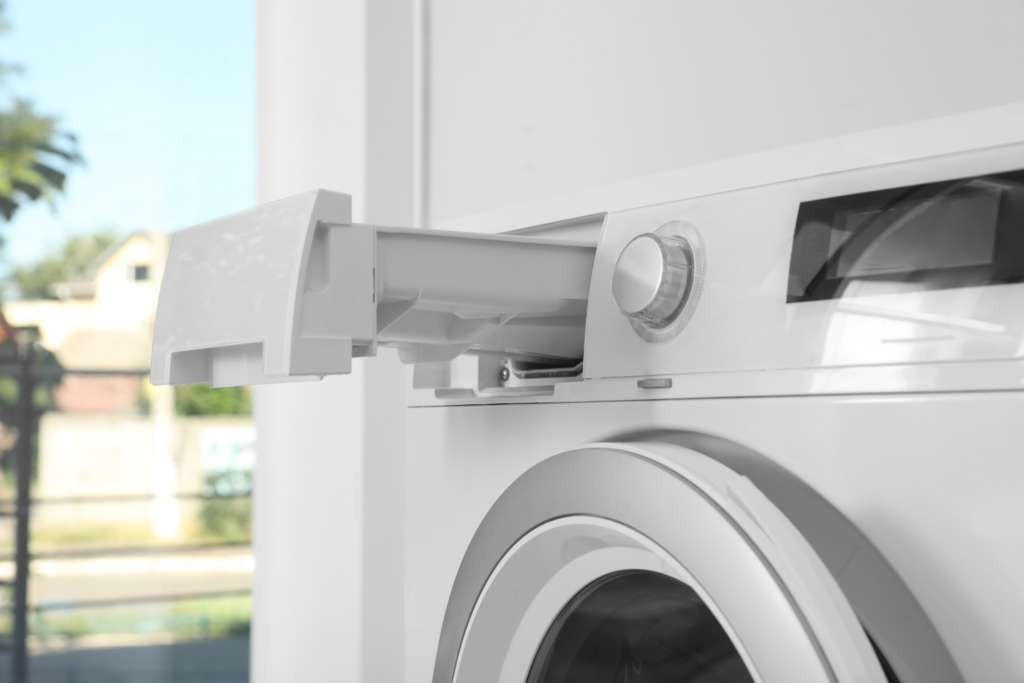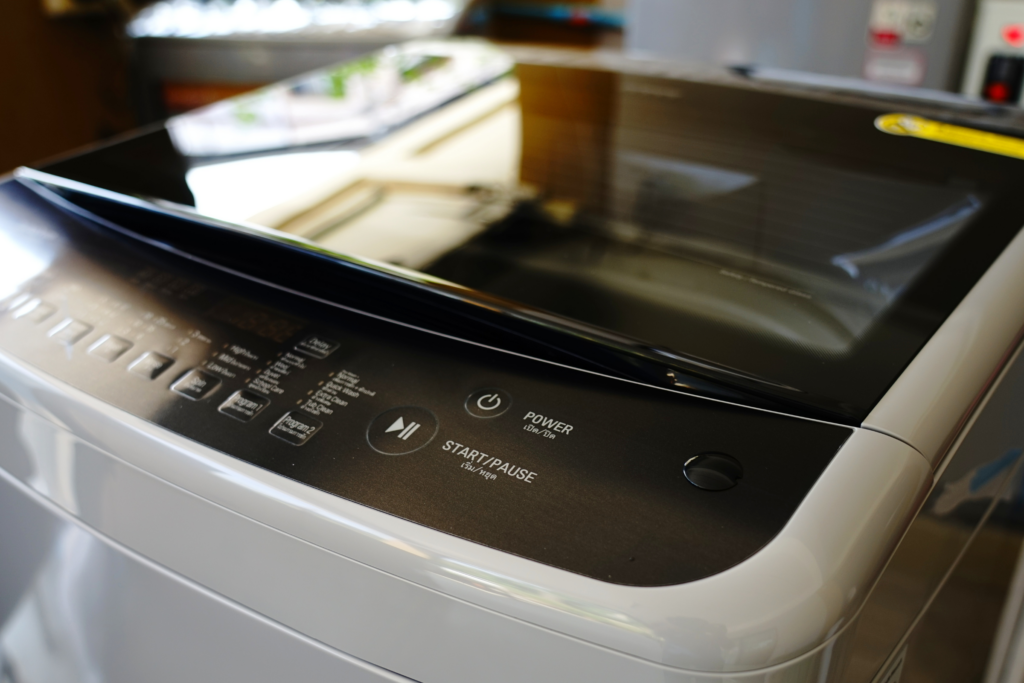Steam Coming Out of the Washing Machine? (Soap Tray, Door, Drum, Drain Hose)
In this article, we’ll explore some of the most common causes of steam emerging from the soap drawer, drum, and door of your washing machine.
Steam could be coming from your washing machine because the water temperature is set too high, there is a leak in the door seal, or hot air is escaping out of the drain hose. In most cases, a little steam coming from the washing machine isn’t a cause for concern, but blockages or component failure is possible.
By identifying the specific cause of steam in your washing machine and understanding how it affects the performance of the appliance, you can take appropriate steps to address the issue and prevent future occurrences.
Is it normal for steam to come out of your washing machine?
It is not normal for steam to come out of a washing machine because washing machines are designed to operate as a fully closed unit that doesn’t allow any excess heat or steam to escape during normal operation.
Usually, steam can be seen coming out of the washing machine through the soap drawer, drum, or door. If too much steam builds up in the machine, it may escape through these openings. Although it is normal for some steam to be released, excessive steaming could signal potential issues with your machine such as a faulty heating element or clogged vents.
Steam in a washing machine is typically created in the main drum during the wash cycle. This is because many washing machines have an internal heater that heats water, turning it into steam that gets injected into the drum. The steam is capable of penetrating deeper into fabric fibers than water alone, allowing for a more thorough and hygienic clean.
The steam also offers several benefits for your clothes and the washing process. Firstly, it helps reduce wrinkling, which in turn minimizes the amount of ironing needed afterward. Secondly, steam is effective at killing bacteria and allergens present in the fabric, making it a more sanitary option.

Why is steam coming out of the soap drawer in my washing machine?
If you notice steam coming from the soap drawer on your washing machine, there’s no need to panic. It might be surprising, but it’s not always a cause for concern. To handle this situation effectively, follow these simple steps:
- The washing machine temperature was set too high: Make sure you have selected the correct temperature for the wash cycle. Steam could be coming from the soap drawer if the water is too hot. Lower the temperature if necessary, and keep an eye on the steam issue during the next cycle.
- Inspect the soap drawer: Look for detergent residue or other blockages in the soap dispenser area. Detergent residues can cause steam to get trapped and escape through the soap drawer. A thorough cleaning should help fix the issue.
- Clean the soap drawer: Remove the soap drawer and clean it thoroughly with warm water and a mild detergent. Pay special attention to the compartments for detergent, bleach, or fabric softener. Rinse the drawer well and let it dry before reinserting it.
- Examine detergent usage: Ensure you are using the recommended amount of detergent for your washing machine. Overuse of detergent can lead to excessive suds and blockages, causing steam to get trapped and escape through the soap drawer.
- Check for blockages in the washer: Look for any blockages in the drum and the hoses connecting the soap dispenser to the drum. Unblock any visible debris and run an empty wash cycle to see if the steam issue is resolved.

Why is steam coming out of the drum of my washing machine?
If you notice steam coming from the drum of your washing machine, don’t panic. Here are the most common reasons:
- Check Door Seal and Gasket – Inspect the door seal and gasket around the washing machine drum. These parts keep water and steam inside the machine.
- Temperature Settings – Review the temperature settings on your washing machine. High-temperature washes create more steam.
- Balance and Level the Machine – Make sure your washing machine is properly balanced and leveled. An unbalanced machine can shake during the spin cycle, loosening the door seal.
- Clean Residue and Filters – Address any detergent residue or clogged filters. Clean the detergent drawer, drain filter, and, if possible, the drum.
- Avoid Overloading – Don’t overload the washing machine. A too-full drum prevents proper water and heat circulation.

Why is steam coming out of the door of my washing machine?
If you notice steam coming out of your washing machine door, don’t worry, it is common for some steam to be present during certain cycles.
- Check the door seal (gasket) – Your washing machine door has a rubber seal or gasket that prevents water and steam from leaking out. Over time, the seal can get damaged or worn, which could cause steam to escape from the door. Inspect the seal carefully for any signs of damage, and replace it if necessary.
- Ensure proper door closure – Make sure the washing machine door is closed completely and securely. If the door is not closed correctly, steam could escape through gaps between the door and the drum. Additionally, some washing machines have a sensor that prevents the cycle from starting if the door isn’t completely closed, so double-check that the door is securely latched.
- Clean the soap drawer – Soap residue can sometimes build up in the washing machine’s soap drawer and create an overflow of foam and steam. Pull out the soap drawer, clean it thoroughly with hot water, and use a brush to remove any soap or dirt buildup. Remember to also clean the area where the drawer slides in, as soap residue can accumulate there as well.
- Avoid overloading – Overloading the washing machine can cause pressure and steam buildup within the drum. That excess steam might escape from the door area. Make sure you’re adding the right amount of laundry according to the machine’s capacity.
- Use the correct detergent – Some detergents may produce more foam and steam than others. Ensure that you’re using the recommended detergent for your washing machine and following the manufacturer’s guidelines regarding the amount of detergent to use.

Why is steam coming from the drain hose on my washing machine?
It might be a little alarming if you see steam coming out of the drain area of your laundry room, but it is likely just steam escaping when the machine dumps hot water out in between cycles.
If it is a lot of steam, however, there are some things to check:
- Check the water temperature setting: Ensure that you have selected the correct temperature for your laundry load. Some fabrics, like wool and delicates, require lower temperatures, while cotton and linens may need higher settings. Adjust the temperature accordingly.
- Inspect the drain hose: Turn off your washing machine, disconnect it from the power source, and examine the drain hose for any visible damage or kinks. Ensure that the hose is securely connected to both the washing machine and the drain.
- Clear any potential blockages: Remove the drain hose from the washing machine and the drain pipe. Use a long brush or a flexible plumber’s snake to clear out any debris, lint, or soap build-up from the hose and the pipe. Blockages can cause improper water drainage, which may lead to steam escaping from the hose.
- Ensure proper ventilation: Make sure that your laundry room or area is well-ventilated. Good air circulation helps eliminate excess moisture, which can contribute to steam-related issues.
- Check for proper hose installation: If you have recently installed or moved your washing machine, double-check that the drain hose has been installed according to the manufacturer’s instructions. Incorrect installation may cause steam to escape from the hose.
- Evaluate your detergent usage: Overusing detergent can cause excess foam, leading to steam in the drain hose. Always follow the manufacturer’s recommendations for detergent usage, and opt for a high-efficiency (HE) detergent when possible, as it produces less foam.
When to contact a professional about steam coming from your washing machine
While a bit of steam might not be considered a problem, a large amount of steam escaping from ANYWHERE on your washing machine should be looked into and resolved.
If the basic walkthroughs we outlined above aren’t doing the trick, you might need to call someone.
Here are some indications when it’s time to contact a professional:
- Steam coming from the soap drawer, instead of just the drum or door
- Persistent steam or smoke during and after the wash cycle
- An unusual smell accompanying the steam or smoke
- Dripping condensation under the soap drawer
- Ineffective cleaning or prolonged wash cycles
It’s essential to be vigilant for any abnormal steam occurrences or additional red flags. When in doubt, don’t hesitate to contact a professional technician to inspect and resolve any potential issues with your washing machine.
Good Preventive Maintenance Best Practices for Your Washing Machine
Regular cleaning not only keeps your washing machine in good condition but also helps prevent the buildup of dirt, debris and mildew that can lead to unpleasant odors. It’s important to wipe up spills promptly and clean the exterior of your washer with a damp cloth.
Pay attention to the fabric softener, bleach, and detergent dispensers, as they can also accumulate residue over time.
For the drum, it’s a good idea to run an empty wash cycle with a washing machine cleaner or a mixture of hot water and vinegar to eliminate any built-up grime. Don’t forget to clean the lint filter regularly, as it can also accumulate dirt and debris.
Dealing with condensation and odors in your washing machine
Condensation can often lead to the growth of mildew and an unpleasant smell in your washing machine. It’s essential to address these issues promptly, so they don’t affect the performance and longevity of your appliance. Here are a few steps to help you prevent and deal with condensation and odors:
- Ventilate: Keep your laundry room well-ventilated and leave the washing machine door open between washes to allow air to circulate and dry out the interior.
- Use the right detergent: Opt for a high-efficiency (HE) detergent, which produces fewer suds and is less likely to cause residue buildup, leading to fewer odors.
- Clean the seals: The rubber door seals can trap debris and create a breeding ground for mildew. Regularly inspect and clean the seals to keep them free from dirt and grime.
- Limit moisture: If possible, reduce humidity in the room by using a dehumidifier or an exhaust fan.
By following these preventive maintenance best practices, you can keep your washing machine running efficiently, prevent the buildup of condensation and unpleasant odors, and prolong the life of your appliance. Remember that regular cleaning and proper care are essential for optimal performance and longevity.
Recommended Posts
Let Us Know How We’re Doing!
Did this expertly prepared resource answer your question?
Do you have another question about home maintenance, home improvement projects, home appliance repair, or something else?
Get more information, send in questions and keep the discussion going by contacting the I’ll Just Fix It Myself company customer service team at at 1-800-928-1490 or Email us at [email protected]
